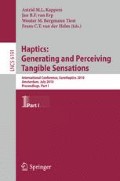Abstract
In this study, tactile afferents in monkey fingertips were mechanically stimulated, using a flat disc shaped probe, with several magnitudes of torque, in clockwise and anticlockwise directions. In order to prevent slip during the stimulation event, a sufficient normal force was also applied, with three different magnitudes tested. Recordings were made from afferents innervating the glabrous skin covering the entire distal segment of the finger. A Parzen window classifier was used to assess the capacity of tactile afferents to discriminate, concurrently and in real-time, the three stimulus parameters; namely, background normal force, torque magnitude and direction. Despite the potentially confounding interactions between stimulus parameters, classification accuracy was very high and was improved even further by selecting subsets of best performing afferents.
Access this chapter
Tax calculation will be finalised at checkout
Purchases are for personal use only
Preview
Unable to display preview. Download preview PDF.
References
Flanagan, J.R., Bowman, M.C., Johansson, R.S.: Control strategies in object manipulation tasks. Curr. Opin. Neurobiol. 16, 650–659 (2006)
Johansson, R.S., Westling, G.: Roles of glabrous skin receptors and sensorimotor memory in automatic control of precision grip when lifting rougher or more slippery objects. Exp. Brain Res. 56, 550–564 (1984)
Kinoshita, H., Bäckström, L., Flanagan, J.R., Johansson, R.S.: Tangential torque effects on the control of grip forces when holding objects with a precision grip. J. Neurophysiol. 78, 1619–1630 (1997)
Goodwin, A.W., Jenmalm, P., Johansson, R.S.: Control of grip force when tilting objects: effect of curvature of grasped surfaces and of applied tangential torque. J. Neurosci. 18, 10724–10734 (1998)
Wing, A.M., Lederman, S.J.: Anticipating load torques produced by voluntary movements. J. Exp. Psychol. Hum. Percept. Perform. 24, 1571–1581 (1998)
Johansson, R.S., Backlin, J.L., Burstedt, M.K.O.: Control of grasp stability during pronation and supination movements. Exp. Brain Res. 128, 20–30 (1999)
Burstedt, M.K.O., Flanagan, R., Johansson, R.S.: Control of grasp stability in humans under different frictional conditions during multi-digit manipulation. J. Neurophysiol. 82, 2393–2405 (1999)
Flanagan, J.R., Burstedt, M.K.O., Johansson, R.S.: Control of fingertip forces in multi-digit manipulation. J. Neurophysiol. 81, 1706–1717 (1999)
Latash, M.L., Shim, J.K., Gao, F., Zatsiorsky, V.M.: Rotational equilibrium during multi-digit pressing and prehension. Motor Control 8, 392–404 (2004)
Shim, J.K., Latash, M.L., Zatsiorsky, V.M.: Prehension synergies in three dimensions. J. Neurophysiol. 93, 766–776 (2005)
Shim, J.K., Park, J., Zatsiorsky, V.M., Latash, M.L.: Adjustments of prehension synergies in response to self-triggered and experimenter-triggered load and torque perturbations. Exp. Brain Res. 175, 641–653 (2006)
Nowak, D.A., Glasauer, S., Hermsdörfer, J.: Grip force efficiency in long-term deprivation of somatosensory feedback. Neuroreport 14, 1803–1807 (2003)
Birznieks, I., Jenmalm, P., Goodwin, A.W., Johansson, R.S.: Encoding of Direction of Fingertip Forces by Human Tactile Afferents. J. Neurosci. 21, 8222–8237 (2001)
Goodwin, A.W., Browning, A.S., Wheat, H.E.: Representation of curved surfaces in responses of mechanoreceptive afferent fibers innervating the monkey’s fingerpad. J. Neurosci. 15, 798–810 (1995)
Vallbo, A.B., Johansson, R.S.: Properties of cutaneous mechanoreceptors in the human hand related to touch sensation. Hum. Neurobiol. 3, 3–14 (1984)
Duda, R.O., Hart, P.E., Stork, D.G.: Pattern Classification, 2nd edn. John Wiley & Sons, Chichester (2001)
Author information
Authors and Affiliations
Editor information
Editors and Affiliations
Rights and permissions
Copyright information
© 2010 Springer-Verlag Berlin Heidelberg
About this paper
Cite this paper
Redmond, S.J., Birznieks, I., Lovell, N.H., Goodwin, A.W. (2010). Classifying Torque, Normal Force and Direction Using Monkey Afferent Nerve Spike Rates. In: Kappers, A.M.L., van Erp, J.B.F., Bergmann Tiest, W.M., van der Helm, F.C.T. (eds) Haptics: Generating and Perceiving Tangible Sensations. EuroHaptics 2010. Lecture Notes in Computer Science, vol 6191. Springer, Berlin, Heidelberg. https://doi.org/10.1007/978-3-642-14064-8_7
Download citation
DOI: https://doi.org/10.1007/978-3-642-14064-8_7
Publisher Name: Springer, Berlin, Heidelberg
Print ISBN: 978-3-642-14063-1
Online ISBN: 978-3-642-14064-8
eBook Packages: Computer ScienceComputer Science (R0)

